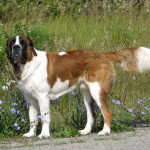Saint Bernard
Other names for this breed:St. Bernhardshund, Alpine Mastiff
Country of origin:Switzerland
Traits:
Weight:Male 140-180 pounds, female 120-140 pounds
Height:Male 28-30 inches, female 26-28 inches
Coat:Short and double coat, smooth or rough
Color:White with brindle, brown, mahogany, orange, red, rust, or brown
Life span:8-10 years
Classification:
AKC - American Kennel Club: Working
UKC - United Kennel Club: Guard
TKC - The Kennel Club: Working
NZKC - New Zealand Kennel Club: Utility
FCI - International: 2 - Pinschers and Schnauzers, Molossoids and Swiss Mountain Dogs, 2.2 - Molossoid Breeds, 2.3 - Swiss Mountain Dog Breeds
Saint Bernard is one of the most recognizable dog breeds in the world. This is largely thanks to their incredible presence and friendly nature as well as their reputation for being excellent family pets. Unfortunately, this breed has also been associated with certain myths and misconceptions that many people believe about them.
Let’s take a closer look at everything you need to know about these dogs so that you can make an informed decision when adopting one into your home.
What is the Saint Bernard’s History?
Saint Bernard’s history is a complex one, with many theories and ideas about their origins. Many people think that these dogs came from the Great Pyrenees and the Basque Sherpas of the Pyrenees Mountains. Some think that Saint Bernards are descendants of the Greyhounds of the Crusades. But there is also evidence that these dogs originated in the Sierras of what is now Switzerland.
These dogs were first brought to France from the Sierras in the 18th century and were dubbed Saint Bernard in honor of the patron saint of mountains, Saint Bernard of the Sierras. The breed was primarily used to haul supplies and pull carts up the steep mountains.
Saint Bernard Appearance and Personality
There are many myths and misconceptions about Saint Bernard’s appearance, but these dogs actually come in a variety of different colors, including black, white, grey, and even blue. They also come in a variety of different sizes, and it’s common for them to weigh over 120 pounds.
Additionally, these dogs can come in a variety of different coat lengths, including a double coat, a curly coat, or a straight coat.
As for their personality, these big dogs are very friendly and affectionate and make excellent family pets. Saint Bernards are very friendly towards people and other dogs, as well as animals like cats. Additionally, they are great with kids and make excellent playmates, as they are full of energy and love to run around and play with children.
Saint Bernard Health
One of the most common health concerns for Saint Bernard’s is the development of degenerative mylopathy, a condition that causes spinal cord degeneration. However, most Saint Bernards do not develop this condition, and if they do, the condition is usually only seen in giant and giant-sized Saint Bernard dogs. These dogs are also at a higher risk of developing hip dysplasia and epilepsy.
Additionally, Saint Bernard is susceptible to many different types of allergies, including allergies to pollen and dust. Saint Bernards also have an increased risk of bloat, which is an extremely serious condition that can cause a dog’s stomach to become swollen due to a blockage caused by a rope or object in their stomach. If a dog has bloat, it will often vomit and become unresponsive and very weak. If a dog shows any signs of bloat, such as vomiting, lethargy, and an inability to walk, you should take the dog to a veterinarian immediately.
Like all large breeds, Saint Bernards are more likely to develop certain health concerns, including hip dysplasia, bloat, and allergies. These same concerns also apply to smaller dogs, like the Pomeranian, and they can be prevented by regular vet visits and a healthy diet.
Saint Bernard Training and Behavior
Saint Bernards are very affectionate and friendly towards humans, so it’s important to keep them in the right training and behavior. Saint Bernard’s are very active dogs that need plenty of daily exercise, and they are not the best breed for apartment living.
These dogs are also very intelligent, but they can also be stubborn, so you will need to be patient and firm with them when training.
Saint Bernard Rescue Group
Saint Bernard has been in danger of becoming extinct in recent years, and as a result, the Saint Bernard Club of America has been created to help protect and preserve this breed. The Saint Bernard Club of America was founded in 1997 and has helped increase the popularity of the Saint Bernard breed by promoting the breed and educating the public about Saint Bernards.
As a result, the number of Saint Bernard dogs in the United States has increased from 300 in 1995 to over 2,000 today.
The Saint Bernard as a Pet: Pros and Cons
Overall, Saint Bernard breeds make great family pets. They are very friendly and affectionate towards both humans and other pets.
Additionally, they are very intelligent dogs that can be trained to perform a variety of tricks and services, such as being a guide dog for the visually impaired or being a police dog.
However, these dogs are very active, so they need plenty of daily exercise. Additionally, they are susceptible to a number of health problems, including hip dysplasia, bloat, and allergies.
And they are also very large, so they are not the best choice for apartment living.
Saint Bernard Photo Gallery
You can click on the gallery images below to view them full sized (most are in wallpaper resolution!).































